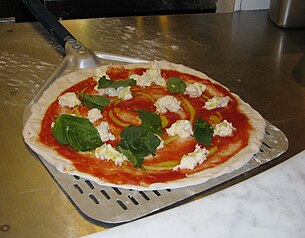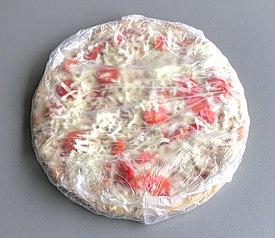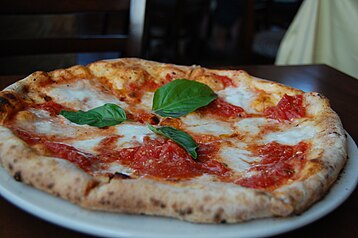Pizza
 A pizza divided into eight slices | |
| Type | Flatbread |
|---|---|
| Course | One course meal |
| Place of origin | Italy |
| Region or state | Naples, Campania |
| Serving temperature | Hot or warm |
| Main ingredients | Dough, sauce (usually tomato sauce), cheese (typically mozzarella) |
| Variations | Calzone, panzerotti |
| Part of a series on |
| Pizza |
|---|
Pizza[a][1] is an Italian dish typically consisting of a flat base of leavened wheat-based dough topped with tomato, cheese, and other ingredients, baked at a high temperature, traditionally in a wood-fired oven.
The term pizza was first recorded in 997 AD, in a Latin manuscript from the southern Italian town of Gaeta, in Lazio, on the border with Campania.[2] Raffaele Esposito is often credited for creating the modern pizza in Naples.[3][4][5][6] In 2009, Neapolitan pizza[7] was registered with the European Union as a traditional speciality guaranteed (TSG) dish. In 2017, the art of making Neapolitan pizza was included on UNESCO's list of intangible cultural heritage.[8]
Pizza and its variants are among the most popular foods in the world. Pizza is sold at a variety of restaurants, including pizzerias (pizza specialty restaurants), Mediterranean restaurants, via delivery, and as street food.[9] In Italy, pizza served in a restaurant is presented unsliced, and is eaten with the use of a knife and fork.[10][11] In casual settings, however, it is typically cut into slices to be eaten while held in the hand. Pizza is also sold in grocery stores in a variety of forms, including frozen or as kits for self-assembly. Store-bought pizzas are then cooked using a home oven.
In 2017, the world pizza market was US$128 billion, and in the US it was $44 billion spread over 76,000 pizzerias.[12] Overall, 13% of the US population aged two years and over consumed pizza on any given day.[13]
Etymology
The oldest recorded usage of the word pizza is from a Latin text from the town of Gaeta, then still part of the Byzantine Empire, in 997 AD; the text states that a tenant of certain property is to give the bishop of Gaeta duodecim pizze (lit. 'twelve pizzas') every Christmas Day, and another twelve every Easter Sunday.[2][14]
Suggested etymologies include:
- Byzantine Greek and Late Latin pitta > pizza, cf. Modern Greek pitta bread and the Apulia and Calabrian (then Byzantine Italy) pitta,[15] a round flat bread baked in the oven at high temperature sometimes with toppings. The word pitta can in turn be traced to either Ancient Greek πικτή (pikte), 'fermented pastry', which in Latin became picta, or Ancient Greek πίσσα (pissa, Attic: πίττα, pitta), 'pitch',[16][17] or πήτεα (pḗtea), 'bran' (πητίτης, pētítēs, 'bran bread').[18]
- The Etymological Dictionary of the Italian Language explains it as coming from dialectal pinza, 'clamp', as in modern Italian pinze, 'pliers, pincers, tongs, forceps'. Their origin is from Latin pinsere, 'to pound, stamp'.[19]
- The Lombardic word bizzo or pizzo, meaning 'mouthful' (related to the English words bit and bite), which was brought to Italy in the middle of the 6th century AD by the invading Lombards.[2][20] The shift b>p could be explained by the High German consonant shift, and it has been noted in this connection that in German the word Imbiss means 'snack'.
A small pizza is sometimes called pizzetta.[21] A person who makes pizza is known as a pizzaiolo.[22]
The word pizza was borrowed from Italian into English in the 1930s; before it became well known, pizza was called "tomato pie" by English speakers. Some regional pizza variations still use the name tomato pie.[23]
History
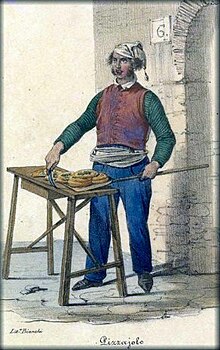
Records of pizza-like foods can be found throughout ancient history. In the 6th century BC, the Persian soldiers of the Achaemenid Empire during the rule of Darius the Great baked flatbreads with cheese and dates on top of their battle shields[24][25] and the ancient Greeks supplemented their bread with oils, herbs, and cheese.[26][27] An early reference to a pizza-like food occurs in the Aeneid, when Celaeno, queen of the Harpies, foretells that the Trojans would not find peace until they are forced by hunger to eat their tables (Book III). In Book VII, Aeneas and his men are served a meal that includes round cakes (such as pita bread) topped with cooked vegetables. When they eat the bread, they realize that these are the "tables" prophesied by Celaeno.[28] In 2023, archeologists discovered a fresco in Pompeii appearing to depict a pizza-like dish among other foodstuffs and staples on a silver platter. Italy's culture minister said it "may be a distant ancestor of the modern dish".[29][30] The first mention of the word pizza comes from a notarial document written in Latin and dating to May 997 AD from Gaeta, demanding a payment of "twelve pizzas, a pork shoulder, and a pork kidney on Christmas Day, and 12 pizzas and a couple of chickens on Easter Day".[31]
Modern pizza evolved from similar flatbread dishes in Naples, Italy, in the 18th or early 19th century.[32] Before that time, flatbread was often topped with ingredients such as garlic, salt, lard, and cheese. It is uncertain when tomatoes were first added and there are many conflicting claims,[32] although it certainly could not have been before the 16th century and the Columbian Exchange. Pizza was sold from open-air stands and out of pizza bakeries until about 1830, when pizzerias in Naples started to have stanze with tables where clients could sit and eat their pizzas on the spot.[33]
A popular contemporary legend holds that the archetypal pizza, pizza Margherita,[34] was invented in 1889, when the Royal Palace of Capodimonte commissioned the Neapolitan pizzaiolo ('pizza maker') Raffaele Esposito to create a pizza in honor of the visiting Queen Margherita. Of the three different pizzas he created, the queen strongly preferred a pizza swathed in the colors of the Italian flag—red (tomato), green (basil), and white (mozzarella). Supposedly, this type of pizza was then named after the queen,[35] with an official letter of recognition from the queen's "head of service" remaining to this day on display in Esposito's shop, now called the Pizzeria Brandi.[36] Later research cast doubt on this legend, undermining the authenticity of the letter of recognition, pointing that no media of the period reported about the supposed visit and that both the story and name Margherita were first promoted in the 1930s–1940s.[37][38]
Pizza was taken to the United States by Italian immigrants in the late 19th century[39] and first appeared in areas where they concentrated. The country's first pizzeria, Lombardi's, opened in New York City in 1905.[40] Italian Americans migrating from East to West brought the dish with them, and from there, the American version was exported to the rest of the world.[41]
The Associazione Verace Pizza Napoletana (lit. 'True Neapolitan Pizza Association') is a non-profit organization founded in 1984 with headquarters in Naples that aims to promote traditional Neapolitan pizza.[42] In 2009, upon Italy's request, Neapolitan pizza was registered with the European Union as a traditional speciality guaranteed (TSG) dish,[43][44] and in 2017 the art of its making was included on UNESCO's list of intangible cultural heritage.[8]
Preparation
Pizza is sold fresh or frozen, and whole or in portion-size slices. Methods have been developed to overcome challenges such as preventing the sauce from combining with the dough, and producing a crust that can be frozen and reheated without becoming rigid. There are frozen pizzas with raw ingredients and self-rising crusts.
In the US, another form of pizza is available from take and bake pizzerias. This pizza is assembled in the store, then sold unbaked to customers to bake in their own ovens. Some grocery stores sell fresh dough along with sauce and basic ingredients, to assemble at home before baking in an oven.
- Pizza preparation
-
Tossing pizza dough to stretch it
-
An unbaked Neapolitan pizza on a metal peel, ready for the oven
-
A wrapped, mass-produced frozen pizza to be baked at home
Baking
In restaurants, pizza can be baked in an oven with fire bricks above the heat source, an electric deck oven, a conveyor belt oven, or, in traditional style in a wood or coal-fired brick oven. The pizza is slid into the oven on a long paddle, called "peel", and baked directly on hot bricks, a screen (a round metal grate, typically aluminum), or whatever the oven surface is. Before use, a peel is typically sprinkled with cornmeal to allow the pizza to easily slide on and off it.[45] When made at home, a pizza can be baked on a pizza stone in a regular oven to reproduce some of the heating effect of a brick oven. Cooking directly on a metal surface results in too rapid heat transfer to the crust, burning it.[46] Some home chefs use a wood-fired pizza oven, usually installed outdoors. As in restaurants, these are often dome-shaped, as pizza ovens have been for centuries,[47] in order to achieve even heat distribution. Another variation is grilled pizza, in which the pizza is baked directly on a barbecue grill. Some types, such as Sicilian pizza, are baked in a pan rather than directly on the bricks of the pizza oven.
Most restaurants use standard and purpose-built pizza preparation tables to assemble their pizzas. Mass production of pizza by chains can be completely automated.
- Pizza baking
-
Pizzas baking in a traditional wood-fired brick oven
-
A pizza being removed with a wooden peel
-
Charred crust on a pizza Margherita, an acceptable trait in artisanal pizza
-
Pizza grilling on an outdoor gas range
Crust
The bottom of the pizza, called the "crust", may vary widely according to style—thin as in a typical hand-tossed Neapolitan pizza or thick as in a deep-dish Chicago-style. It is traditionally plain, but may also be seasoned with garlic or herbs, or stuffed with cheese. The outer edge of the pizza is sometimes referred to as the cornicione.[48] Some pizza dough contains sugar, to help its yeast rise and enhance browning of the crust.[49]
Dipping sauce specifically for pizza was invented by American pizza chain Papa John's Pizza in 1984 and has since been adopted by some when eating pizza, especially the crust.[50]
Cheese
Mozzarella is commonly used on pizza, with the buffalo mozzarella produced in the surroundings of Naples.[51] Other cheeses are also used, particularly burrata, Gorgonzola, provolone, pecorino romano, ricotta, and scamorza. Less expensive processed cheeses or cheese analogues have been developed for mass-market pizzas to produce desirable qualities such as browning, melting, stretchiness, consistent fat and moisture content, and stable shelf life. This quest to create the ideal and economical pizza cheese has involved many studies and experiments analyzing the impact of vegetable oil, manufacturing and culture processes, denatured whey proteins, and other changes in manufacture. In 1997, it was estimated that annual production of pizza cheese was 1 million metric tons (1,100,000 short tons) in the US and 100,000 metric tons (110,000 short tons) in Europe.[52]
Varieties and styles
A great number of pizza varieties exist, defined by the choice of toppings and sometimes also crust. There are also several styles of pizza, defined by their preparation method. The following lists feature only the notable ones.
Varieties
| Image | Name | Characteristic ingredients | Origin | First attested | Notes |
|---|---|---|---|---|---|

|
Pizza Margherita | Tomatoes, mozzarella, basil. | Naples, Italy | June 1889 | The archetypical Neapolitan pizza. |
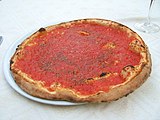
|
Pizza marinara | Tomato sauce, olive oil, oregano, garlic. No cheese. | Naples, Italy | 1734 | One of the oldest Neapolitan pizza. |

|
Pizza capricciosa | Ham, mushrooms, artichokes, egg. | Rome, Lazio, Italy | 1937 | Similar to pizza quattro stagioni, but with toppings mixed rather than separated. |

|
Pizza quattro formaggi | Prepared using four types of cheese (Italian: [ˈkwattro forˈmaddʒi], 'four cheeses'): mozzarella, Gorgonzola and two others depending on the region. | Lazio, Italy | Its origins are not clearly documented, but it is believed to originate from the Lazio region at the beginning of the 18th century.[53] | |

|
Pizza quattro stagioni | Artichokes, mushroom, ham, tomatoes. | Campania, Italy | The toppings are separated by quarter, representing the cycle of the seasons. | |

|
Seafood pizza | Seafood, such as fish, shellfish or squid. | Italy | Subvarieties include pizza ai frutti di mare (no cheese) and pizza pescatore (with mussels or squid). |
Styles
| Image | Name | Characteristics | Origin | First attested |
|---|---|---|---|---|

|
Calzone | Pizza folded in half turnover-style. | Naples, Italy | 1700s |

|
Deep fried pizza (pizza fritta) | The pizza is deep fried (cooked in oil) instead of baked. | Italy | |

|
Pizzetta | Small pizza served as an hors d'oeuvre or snack. | Italy | |

|
California-style pizza | Distinguished by the use of non-traditional ingredients, especially varieties of fresh produce. | California, U.S. | 1980 |

|
Chicago-style pizza | Baked in a pan with a high edge that holds in a thick layer of toppings. The crust is sometimes stuffed with cheese or other ingredients. | Chicago, U.S. | c. 1940s |

|
Colorado-style pizza | Made with a characteristically thick, braided crust topped with heavy amounts of sauce and cheese. It is traditionally served by the pound, with a side of honey as a condiment. | Colorado, U.S. | 1973 |

|
Detroit-style pizza | The cheese is spread to the edges and caramelizes against the high-sided heavyweight rectangular pan, giving the crust a lacy, crispy edge. | Detroit, U.S. | 1946 |

|
New York–style pizza | Neapolitan-derived pizza with a characteristic thin foldable crust. | New York metropolitan area (and beyond) | Early 1900s |

|
St. Louis–style pizza | The style has a thin cracker-like crust made without yeast, generally uses Provel cheese, and is cut into squares or rectangles instead of wedges. | St. Louis, U.S. | 1945 |
By region of origin
Italy

Authentic Neapolitan pizza (Italian: pizza napoletana) is made with San Marzano tomatoes, grown on the volcanic plains south of Mount Vesuvius, and either mozzarella di bufala campana, made with milk from water buffalo raised in the marshlands of Campania and Lazio,[55] or fior di latte.[56] Buffalo mozzarella is protected with its own European protected designation of origin (PDO).[55] Other traditional pizzas include pizza marinara, supposedly the most ancient tomato-topped pizza,[57] pizza capricciosa, which is prepared with mozzarella cheese, baked ham, mushroom, artichoke, and tomato.[58]
A popular variant of pizza in Italy is Sicilian pizza (locally called sfincione or sfinciuni),[59][60] a thick-crust or deep-dish pizza originating during the 17th century in Sicily: it is essentially a focaccia that is typically topped with tomato sauce and other ingredients. Until the 1860s, sfincione was the type of pizza usually consumed in Sicily, especially in the Western portion of the island.[61] Other variations of pizzas are also found in other regions of Italy, for example pizza al padellino or pizza al tegamino, a small-sized, thick-crust, deep-dish pizza typically served in Turin, Piedmont.[62][63][64]
United States


The first pizzeria in the US was opened in New York City's Little Italy in 1905.[65] Common toppings for pizza in the United States include anchovies, ground beef, chicken, ham, mushrooms, olives, onions, peppers, pepperoni, pineapple, salami, sausage, spinach, steak, and tomatoes. Distinct regional types developed in the 20th century, including Buffalo,[66] California, Chicago, Detroit, Greek, New Haven, New York, and St. Louis styles.[67] These regional variations include deep-dish, stuffed, pockets, turnovers, rolled, and pizza-on-a-stick, each with seemingly limitless combinations of sauce and toppings.
Thirteen percent of the United States population consumes pizza on any given day.[68] Pizza chains such as Domino's Pizza, Pizza Hut, and Papa John's, pizzas from take and bake pizzerias, and chilled or frozen pizzas from supermarkets make pizza readily available nationwide.
Argentina
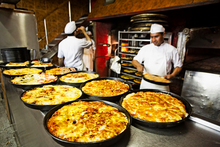
Argentine pizza is a mainstay of the country's cuisine,[69] especially of its capital Buenos Aires, where it is regarded as a cultural heritage and icon of the city.[70][71][72] Argentina is the country with the most pizzerias per inhabitant in the world and, although they are consumed throughout the country, the highest concentration of pizzerias and customers is Buenos Aires, the city with the highest consumption of pizzas in the world (estimated in 2015 to be 14 million per year).[73] As such, the city has been considered as one of the world capitals of pizza.[71][73] The dish was introduced to Buenos Aires in the late 19th century with the massive Italian immigration, as part of a broader great European immigration wave to the country.[71] Thus, around the same time that the iconic pizza Margherita[74] was being invented in Italy, pizza were already being cooked in the Argentine capital.[75] The impoverished Italian immigrants that arrived to the city transformed the originally modest dish into a much more hefty meal, motivated by the abundance of food in Argentina.[73][76] In the 1930s, pizza was cemented as a cultural icon in Buenos Aires, with the new pizzerias becoming a central space for sociability for the working class people who flocked to the city.[76][75]
The most characteristic style of Argentine pizza—which almost all the classic pizzerias in Buenos Aires specialize in—is the so-called pizza de molde (Spanish for 'pizza in the pan'), characterized by having a "thick, spongy base and elevated bready crust".[71] This style, which today[when?] is identified as the typical style of Argentine pizza—characterized by a thick crust and a large amount of cheese—arose when impoverished Italian immigrants found a greater abundance of food in then-prosperous Argentina, which motivated them to transform the originally modest dish into a much more hefty meal suitable for a main course.[73][76] The name pizza de molde emerged because there were no pizza ovens in the city, so bakers resorted to baking them in pans.[77] Since they used bakery plates, Argentine pizzas were initially square or rectangular, a format associated with the 1920s that is still maintained in some classic pizzerias, especially for vegetable pizzas, fugazzetas or fugazzas.[77]
Other styles of Argentine pizza include the iconic fugazza and its derivative fugazzeta or fugazza con queso (a terminology that varies depending on the pizzeria),[71] or the pizza de cancha or canchera (a cheese-less variant).[78] Most pizza menus include standard flavor combinations, including the traditional plain mozzarella, nicknamed "muza" or "musa"; the napolitana or "napo", with "cheese, sliced tomatoes, garlic, dried oregano and a few green olives", not to be confused with Neapolitan pizza;[71] calabresa, with slices of longaniza;[79] jamon y morrones, with sliced ham and roasted bell peppers;[71] as well as versions with provolone, with anchovies,[79] with hearts of palm, or with chopped hard boiled egg.[71] A typical custom that is unique to Buenos Aires is to accompany pizza with fainá, a pancake made from chickpea flour.[80]
Dessert pizza
The terms dessert pizza and sweet pizza are used for a variety of dishes resembling a pizza, including chocolate pizza and fruit pizza.[81][82] Some are based on a traditional yeast dough pizza base,[83] while others have a cookie-like base[84] and resemble a traditional pizza solely in having a flat round shape with a distinct base and topping. Some pizza restaurants offer dessert pizzas.[85][86]
Nutrition
Some pizzas mass-produced by American pizza chains have been criticized as having an unhealthy balance of ingredients. Pizza can be high in salt and fat, and is high in calories. The USDA reports an average sodium content of 5,100 mg per 14 in (36 cm) pizza in fast food chains.[87][88][89]
Similar dishes


- Calzone and stromboli are similar dishes that are often made of pizza dough folded (calzone) or rolled (stromboli) around a filling.
- Coca is a similar dish consumed mainly in Catalonia and neighboring regions, but that has extended to other areas in Spain, and to Algeria. There are sweet and savory versions.
- Farinata or cecina is a Ligurian (farinata) and Tuscan (cecina) regional dish.[90] It is often baked in a brick oven, and typically weighed and sold by the slice.
- Flammekueche is a food speciality of the Alsace region.
- Focaccia is a flat leavened oven-baked Italian bread, similar in style and texture to pizza; in some places, it is called pizza bianca (lit. 'white pizza').[91]
- Garlic fingers is an Atlantic Canadian dish, similar to a pizza in shape and size, and made with similar dough. It is garnished with melted butter, garlic, cheese, and sometimes bacon.
- İçli pide, or simply pide, is a Turkish dish, similar to a pizza in being made of wheat-based dough topped with tomato, cheese, and other ingredients, and usually formed in a boat-like shape.
- Khachapuri is a Georgian cheese-filled bread.
- Lahmacun is a Middle Eastern flatbread topped with minced meat; the base is very thin, and the layer of meat often includes chopped vegetables.[92]
- Manakish is a Levantine flatbread dish.
- Matzah pizza is a Jewish pizza dish.
- Panzerotti are similar to calzoni, but fried rather than baked.
- Pastrmalija is a bread pie made from dough and meat. It is usually oval-shaped with chopped meat on top of it.
- Piadina is a thin Italian flatbread, typically prepared in the Romagna historical region.
- Pissaladière is similar to an Italian pizza, with a slightly thicker crust and a topping of cooked onions, anchovies, and olives.
- Pizza bagel is a bagel with toppings similar to that of traditional pizzas.
- Okonomiyaki is a Japanese dish cooked on a hotplate, is often referred to as "Japanese pizza".[93]
- Pizza cake is a multiple-layer pizza.
- Pizza snack rolls are a trade-marked commercial product.
- Pizza strips is a tomato pie of Italian-American origin.
- Wähe is a Swiss type of tart.
- Zanzibar pizza is a street food served in Stone Town, Zanzibar, Tanzania. It uses a dough much thinner than pizza dough, almost like filo dough, filled with minced beef, onions, and an egg, similar to Moroccan basṭīla.[94]
- Zwiebelkuchen is a German onion tart, often baked with diced bacon and caraway seeds.
See also
![]() Media related to Pizzas at Wikimedia Commons
Media related to Pizzas at Wikimedia Commons
- List of pizza chains
- List of pizza varieties by country
- List of baked goods
- Pizza cheese – cheese for use specifically on pizza
- Pizza delivery – service in which a pizzeria delivers pizza to a customer
- Pizza farm – farm split into sections like a pizza split into slices
- Pizza party – social gathering at which pizza is eaten
- Pizza saver – object used to prevent the top of a food container from collapsing
- Pizza theorem – equality of areas of alternating sectors of a disk with equal angles through any interior point
Notes
References
- ^ "144843". Oxford English Dictionary (Online ed.). Oxford University Press. (Subscription or participating institution membership required.)
- ^ a b c Maiden, Martin. "Linguistic Wonders Series: Pizza is a German(ic) Word". yourDictionary.com. Archived from the original on January 15, 2003.
- ^ Arthur Schwartz, Naples at Table: Cooking in Campania (1998), p. 68. ISBN 9780060182618.
- ^ John Dickie, Delizia!: The Epic History of the Italians and Their Food (2008), p. 186.
- ^ Father Giuseppe Orsini, Joseph E. Orsini, Italian Baking Secrets (2007), p. 99.
- ^ "Pizza Margherita: History and Recipe". ITALY Magazine. March 14, 2011. Archived from the original on February 7, 2013. Retrieved February 21, 2022.
- ^ "How to Make Neapolitan Pizza". La Cucina Italiana. June 16, 2020. Retrieved June 18, 2024.
- ^ a b "Naples' pizza twirling wins Unesco 'intangible' status". The Guardian. London. Agence France-Presse. December 7, 2017. ISSN 0261-3077. Archived from the original on December 7, 2017. Retrieved December 7, 2017.
- ^ Miller, Hanna (April–May 2006). "American Pie". American Heritage. Archived from the original on February 3, 2012. Retrieved May 4, 2012.
- ^ Naylor, Tony (September 6, 2019). "How to eat: Neapolitan-style pizza". The Guardian. London. Archived from the original on September 14, 2019. Retrieved September 20, 2019.
- ^ Godoy, Maria (January 13, 2014). "Italians To New Yorkers: 'Forkgate' Scandal? Fuhggedaboutit". The Salt (blog). National Public Radio. Archived from the original on September 20, 2019. Retrieved September 20, 2019.
- ^ Hynum, Rick (December 2016). "Pizza Power 2017 – A State of the Industry Report". PMQ Pizza Magazine. Archived from the original on July 29, 2017. Retrieved July 28, 2017.
- ^ Rhodes, Donna; et al. (February 2014). "Consumption of Pizza" (PDF). Food Surveys Research Group Dietary Data Brief No. 11. USDA. Archived (PDF) from the original on September 30, 2017. Retrieved September 27, 2017.
- ^ Salvatore Riciniello (1987) Codice Diplomatico Gaetano, Vol. I, La Poligrafica.
- ^ Babiniotis, Georgios (2005). Λεξικό της Νέας Ελληνικής Γλώσσας [Dictionary of Modern Greek] (in Greek). Lexicology Centre. p. 1413. ISBN 978-960-86190-1-2.
- ^ "Pizza". Online Etymology Dictionary. Archived from the original on October 24, 2007. Retrieved June 5, 2009.
- ^ "Pissa, Liddell and Scott, "A Greek-English Lexicon, at Perseus". Perseus.tufts.edu. Archived from the original on February 21, 2022. Retrieved June 5, 2009.
- ^ "Pizza". Dictionary.com. Retrieved June 5, 2009.
- ^ "pizza" (Archived February 21, 2022, at the Wayback Machine), Online Etymology Dictionary.
- ^ "Pizza". Garzanti Linguistica. De Agostini Scuola Spa. Archived from the original on February 1, 2014. Retrieved January 31, 2014.
- ^ "pizzetta". Merriam-Webster.com Online Dictionary. June 22, 2023.
- ^ Doane, Seth (November 20, 2022). "Bringing authentic Neapolitan pizza home". CBS News.
- ^ Uyehara, Mari (October 6, 2023). "The Many Lives of Tomato Pie". The New York Times. ISSN 0362-4331. Retrieved October 15, 2023.
- ^ "Pizza, A Slice of American History", Liz Barrett (2014), p. 13.
- ^ "The Science of Bakery Products", W. P. Edwards (2007), p. 199.
- ^ Talati-Padiyar, Dhwani (March 8, 2014). Travelled, Tasted, Tried & Tailored: Food Chronicles. Lulu publishers. ISBN 978-1304961358.
- ^ Buonassisi, Rosario (2000). Pizza: From its Italian Origins to the Modern Table. Firefly. p. 78.
- ^ "Aeneas and Trojans fulfill Anchises' prophecy". Archived from the original on March 29, 2017.
- ^ "Pompeii archaeologists discover 'pizza' painting". BBC News. June 17, 2023.
- ^ "Pizza's possible 'distant ancestor' found painted in the ruins of Pompeii". ABC News. June 27, 2023. Retrieved June 28, 2023.
- ^ "Sorpresa: la parola "pizza" è nata a Gaeta" ["Surprise: the word "pizza" was born in Gaeta]. La Reppublica (in Italian). February 9, 2015. Archived from the original on November 16, 2021. Retrieved November 16, 2021.
- ^ a b Helstosky, Carol (2008). Pizza: A Global History. London: Reaktion. pp. 21–22. ISBN 978-1-86189-391-8.
- ^ de Sanctis, Francesco. La giovinezza di Francesco de Sanctis: frammento autobiografico. p. 39.
In the evening we often used to go eating pizza in some rooms at the Piazza della Carità.
- ^ "Margherita Pizza". La Cucina Italiana. November 9, 2021. Retrieved June 18, 2024.
- ^ "Pizza Margherita: History and Recipe". Italy Magazine. March 14, 2011. Archived from the original on February 7, 2013. Retrieved April 23, 2012.
- ^ Hales, Dianne (May 12, 2009). La Bella Lingua (in Swedish). Crown. p. 204. ISBN 978-0767932110. Retrieved August 29, 2024.
- ^ "Was margherita pizza really named after Italy's queen?". BBC Food. December 28, 2012. Archived from the original on December 31, 2012. Retrieved December 31, 2012.
- ^ Nowak, Zachary (March 2014). "Folklore, Fakelore, History: Invented Tradition and the Origins of the Pizza Margherita". Food, Culture & Society. 17 (1): 103–124. doi:10.2752/175174414X13828682779249. ISSN 1552-8014. S2CID 142371201.
- ^ Helstosky, Carol (2008). Pizza: A Global History. Reaktion Books. p. 48. ISBN 978-1-86189-630-8.
- ^ Nevius, Michelle; Nevius, James (2009). Inside the Apple: A Streetwise History of New York City. New York: Free Press. pp. 194–95. ISBN 978-1416589976.
- ^ Turim, Gayle. "A Slice of History: Pizza Through the Ages". History.com. Archived from the original on December 18, 2014. Retrieved November 9, 2014.
- ^ "Associazione Verace Pizza Napoletana (AVPN)". Archived from the original on July 9, 2017. Retrieved July 11, 2017.
- ^ Official Journal of the European Union, Commission regulation (EU) No 97/2010 Archived 3 June 2013 at the Wayback Machine, 5 February 2010.
- ^ International Trademark Association, European Union: Pizza napoletana obtains "Traditional Speciality Guaranteed" status Archived 19 August 2014 at the Wayback Machine, 1 April 2010.
- ^ Owens, Martin J. (2003). Make Great Pizza at Home. Taste of America Press. p. 3. ISBN 978-0-9744470-0-1. Archived from the original on May 27, 2016. Retrieved December 12, 2015.
- ^ Chen, Angus (July 23, 2018). "Pizza Physics: Why Brick Ovens Bake The Perfect Italian-Style Pie". NPR. Archived from the original on July 24, 2018. Retrieved July 25, 2018.
- ^ "pizza oven kits". Californo. Archived from the original on April 26, 2018. Retrieved April 23, 2018.
- ^ Braimbridge, Sophie; Glynn, Joanne (2005). Food of Italy. Murdoch Books. p. 167. ISBN 978-1-74045-464-3. Archived from the original on June 14, 2016. Retrieved December 12, 2015.
- ^ DeAngelis, Dominick A. (December 1, 2011). The Art of Pizza Making: Trade Secrets and Recipes. The Creative Pizza Company. pp. 20–28. ISBN 978-0-9632034-0-3.
- ^ Shrikant, Adit (July 27, 2017). "How Dipping Sauce for Pizza Became Oddly Necessary". Eater. Vox Media. Archived from the original on July 27, 2017. Retrieved July 28, 2017.
- ^ Anderson, Sam (October 11, 2012). "Go Ahead, Milk My Day". The New York Times. Archived from the original on July 17, 2014. Retrieved November 7, 2014.
- ^ Fox, Patrick F.; et al. (2000). Fundamentals of Cheese Science. Aspen Pub. p. 482. ISBN 978-0-8342-1260-2. Archived from the original on May 14, 2016.
- ^ "La pizza 4 fromages : origines et recettes". Restaurant le Quatre Vingt. May 31, 2017.
- ^ Arturo Iengo (2008). Cucina Napoletana: 100 Recipes from Italy's Most Vibrant City. New Holland Publishers. p. 126. ISBN 978-1-84537-989-6. Archived from the original on June 16, 2018. Retrieved December 12, 2017.
- ^ a b "Selezione geografica". Europa.eu.int. February 23, 2009. Archived from the original on February 18, 2005. Retrieved April 2, 2009.
- ^ "How to Make Neapolitan Pizza". La Cucina Italiana. June 16, 2020. Retrieved June 18, 2024.
- ^ "La vera storia della pizza napoletana". Biografieonline.it. May 20, 2013. Archived from the original on June 29, 2013. Retrieved December 8, 2015.
- ^ Guides, Rough (August 1, 2011). Rough Guides (ed.). Rough Guide Phrasebook: Italian: Italian. Penguin. p. 244. ISBN 978-1-4053-8646-3. Archived from the original on May 12, 2016. Retrieved December 12, 2015.
- ^ "What is Sicilian Pizza?". WiseGeek. Archived from the original on March 14, 2013. Retrieved April 14, 2013.
- ^ Giorgio Locatelli (December 26, 2012). Made In Sicily. Harper Collins. ISBN 978-0-06-213038-9. Archived from the original on May 2, 2021. Retrieved July 4, 2013.
- ^ Gangi, Roberta (2007). "Sfincione". Best of Sicily Magazine. Archived from the original on April 2, 2014.
- ^ "Torino: la riscoperta della pizza al padellino". Agrodolce. April 3, 2014. Archived from the original on December 8, 2015. Retrieved December 8, 2015.
- ^ "Pizza al padellino (o tegamino): che cos'è?". Gelapajo.it. Archived from the original on December 10, 2015. Retrieved December 8, 2015.
- ^ "Beniamino, il profeta della pizza gourmet". Torino – Repubblica.it. January 19, 2013. Archived from the original on December 8, 2015. Retrieved December 8, 2015.
- ^ Otis, Ginger Adams (2010). New York City 7. Lonely Planet. p. 256. ISBN 978-1741795912. Archived from the original on February 21, 2022. Retrieved November 1, 2012.
- ^ Bovino, Arthur (August 13, 2018). "Is America's Pizza Capital Buffalo, New York?". The Daily Beast. Archived from the original on February 21, 2022. Retrieved December 10, 2019.
- ^ "Pizza Garden: Italy, the Home of Pizza". CUIP Chicago Public Schools – University of Chicago Internet Project. Archived from the original on October 19, 2013. Retrieved August 1, 2014.
- ^ Rhodes, Donna G.; Adler, Meghan E.; Clemens, John C.; LaComb, Randy P.; Moshfegh, Alanna J. "Consumption of Pizza" (PDF). Food Surveys Research Group. Archived (PDF) from the original on October 5, 2014. Retrieved September 25, 2014.
- ^ Aeberhard, Danny; Benson, Andrew; Phillips, Lucy (2000). The Rough Guide to Argentina. Rough Guides. p. 40. ISBN 978-185-828-569-6. Retrieved December 10, 2022 – via Google Books.
- ^ Pizzerías de valor patrimonial de Buenos Aires (2008), p. 11.
- ^ a b c d e f g h Lazar, Allie (April 25, 2016). "Buenos Aires Makes Some of the World's Best (and Weirdest) Pizza". Saveur. Retrieved December 10, 2022.
- ^ Sorba, Pietro (October 15, 2021). "La reivindicación de la pizza de molde argentina". Clarín (in Spanish). Buenos Aires. Retrieved August 4, 2023.
- ^ a b c d Gómez, Leire (July 17, 2015). "Buenos Aires: la ciudad de la pizza". Tapas (in Spanish). Madrid: SpainMedia. Retrieved December 10, 2022.
- ^ "Margherita Pizza". La Cucina Italiana. November 9, 2021. Retrieved June 18, 2024.
- ^ a b Hidalgo, Joaquín; Auzmendi, Martín (October 6, 2018). "De Nápoles a la Argentina: la historia de la pizza y cómo llegó a ser un emblema nacional". Entremujeres. Clarín (in Spanish). Retrieved December 10, 2022.
- ^ a b c Acuña, Cecilia (June 26, 2017). "La historia de la pizza argentina: ¿de dónde salió la media masa?". La Nación (in Spanish). Retrieved December 10, 2022.
- ^ a b Pepe Arias, Gimena (June 25, 2022). "Pizza a la piedra vs. pizza al molde: dos estilos que dividen a los argentinos". Clarín (in Spanish). Retrieved December 10, 2022.
- ^ Firpo, Hernán (October 20, 2018). "Angelín cumple 80 años: mitos y verdades de una pizzería indispensable". Clarín (in Spanish). Retrieved December 11, 2022.
- ^ a b "Tipos de pizzas en Argentina". Diario Democracia (in Spanish). Junín. January 10, 2015. Retrieved December 11, 2022.
- ^ Booth, Amy (May 10, 2022). "Buenos Aires' unusual pizza topping". BBC Travel. Retrieved December 10, 2022.
- ^ Colognese, Marco. "Sweet pizza, the new dessert in pizzeria". pizzastories.le5stagioni.it. Retrieved May 6, 2024.
- ^ "These Sweet Dessert Pizza Recipes Are A Little Slice Of Heaven". Delish. June 24, 2020. Retrieved May 6, 2024.
- ^ "Chocolate pizza". Good Food. BBC. Retrieved May 6, 2024.
- ^ "Chocolate Cookie Pizza". BettyCrocker.com. Retrieved May 6, 2024.
- ^ "Menu: Desserts". Pizza Express. Retrieved May 6, 2024.
- ^ "Menu". www.pepeingrani.it. Pepe in Grani. Retrieved May 6, 2024.
- ^ "Basic Report 21299: Fast Food, Pizza Chain, 14" pizza, cheese topping, regular crust". National Nutrient Database for Standard Reference. September 28, 2014. Archived from the original on April 3, 2019. Retrieved September 28, 2014.
- ^ "Survey of pizzas". Food Standards Agency. July 8, 2004. Archived from the original on December 28, 2005. Retrieved April 2, 2009.
- ^ "Health | Fast food salt levels "shocking"". BBC News. October 18, 2007. Archived from the original on January 15, 2009. Retrieved April 2, 2009.
- ^ "Brick Oven Cecina". Fornobravo.com. Archived from the original on October 16, 2006. Retrieved April 2, 2009.
- ^ Riolo, A. (2012). The Mediterranean Diabetes Cookbook. American Diabetes Association. p. 260. ISBN 978-1-58040-483-9.
- ^ McKernan, Bethan (October 27, 2016). "A 'pizza war' has broken out between Turkey and Armenia". The Independent. Archived from the original on December 17, 2016. Retrieved December 10, 2016.
- ^ "hanamiweb.com". Archived from the original on March 18, 2007. Retrieved December 7, 2015.
- ^ Samuelsson, Marcus (2006). The soul of a new cuisine : a discovery of the foods and flavors of Africa. Hoboken, N.J: John Wiley & Sons. ISBN 978-0-7645-6911-1. OCLC 61748426.
Further reading
- Chudgar, Sonya (March 22, 2012). "An Expert Guide to World-Class Pizza". QSR Magazine. Retrieved October 16, 2012.
- Delpha, J.; Oringer, K. (2015). Grilled Pizza the Right Way. Macmillan. ISBN 978-1-62414-106-5.
- Helstosky, Carol (2008). Pizza: A Global History. London: Reaktion Books. ISBN 978-1-86189-391-8. OCLC 225876066.
- Kliman, Todd (September 5, 2012). "Easy as pie: A Guide to Regional Pizza". The Washingtonian. Explanation of eight pizza styles: Maryland, Roman, "Gourmet" Wood-fired, Generic boxed, New York, Neapolitan, Chicago, and New Haven.
- Raichlen, Steven (2008). The Barbecue! Bible. Workman Publishing. pp. 381–384. ISBN 978-0761149446.
- "The Saveur Ultimate Guide to Pizza". Saveur. Retrieved November 2, 2014.



